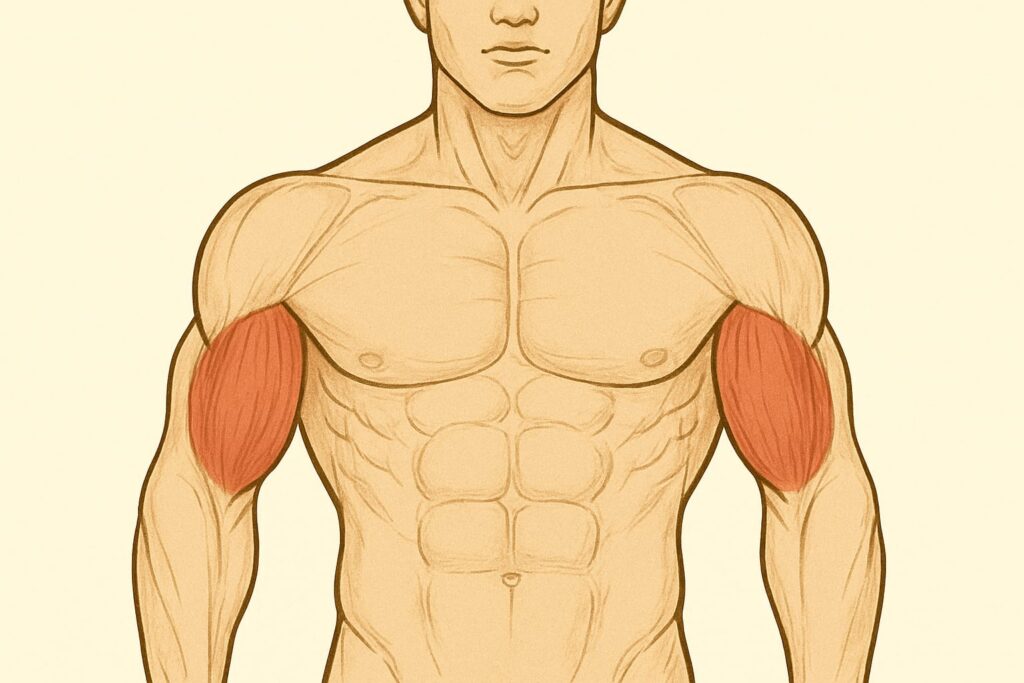Best Biceps Exercises for Growth: With and Without Weights
When it comes to building impressive arms, the biceps play a starring role. Well-developed biceps don’t just improve appearance, they also enhance upper-body strength and athletic performance. Whether you train at home or in the gym, understanding how to target your biceps effectively is crucial for achieving visible, long-term results. In this guide, you’ll discover the best biceps exercises for growth, including options with and without weights. Each movement is explained step by step, so you can perform it safely and maximize muscle activation.

Why Focusing on Biceps Growth Matters
The biceps brachii consists of two heads: the short head (inner part) and the long head (outer part). Together, they control elbow flexion and forearm rotation, two movements essential in daily life and strength training. Strong biceps help stabilize your shoulders and improve your pulling power in exercises like rows and pull-ups.
Moreover, when trained properly, biceps respond quickly to progressive overload, showing visual improvements in just a few weeks. However, balance is key: combining compound and isolation exercises produces the best growth while preventing overtraining.
Best Biceps Exercises for Growth Using Weights
Weighted movements are among the best biceps exercises for growth because they allow you to progressively increase resistance, stimulating muscle hypertrophy. Here are the top gym-based options that deliver real results.
1. Barbell Biceps Curl
Execution:
- Stand tall with feet shoulder-width apart.
- Hold a barbell with an underhand grip, arms extended.
- Curl the bar upward toward your chest while keeping your elbows fixed.
- Slowly lower it back to the starting position.
Why it works:
The barbell curl is a classic for a reason: it allows heavy loads and targets both biceps heads simultaneously. For maximum results, control the eccentric (lowering) phase for at least two seconds.
Tip: Avoid swinging your torso; this reduces biceps tension and risks injury.
2. Dumbbell Alternating Curl
Execution:
- Hold a dumbbell in each hand with palms facing forward.
- Curl one arm at a time, rotating your wrist as you lift.
- Lower slowly, then switch arms.
Why it works:
Alternating curls improve muscle symmetry and ensure balanced strength development. Because each arm works independently, your dominant side can’t take over.
Transition: Moreover, switching from barbell to dumbbells adds variety and prevents plateaus.
3. Hammer Curl
Execution:
- Hold dumbbells with palms facing each other (neutral grip).
- Curl both dumbbells upward until they reach shoulder level.
- Lower slowly under control.
Why it works:
This variation targets the brachialis muscle underneath the biceps, adding overall thickness to the upper arm. It’s also easier on the wrists compared to standard curls.
Tip: Perform it seated or standing; both are effective when done with proper form.
4. Preacher Curl
Execution:
- Sit at a preacher bench with your upper arms resting on the pad.
- Grip an EZ bar or dumbbell with palms facing up.
- Curl the weight upward, pause briefly at the top, then lower slowly.
Why it works:
Because the arms are stabilized, this movement isolates the biceps, removing momentum. It’s one of the best biceps exercises for growth in the mid and lower range of motion.
Transition: In addition, preacher curls help beginners learn strict form.
5. Concentration Curl
Execution:
- Sit on a bench, legs apart.
- Hold a dumbbell in one hand and rest your elbow on the inside of your thigh.
- Curl the dumbbell toward your chest, then lower with control.
Why it works:
This is a powerful isolation move that maximizes the mind-muscle connection. By focusing on one arm at a time, you can feel every contraction deeply.
Pro tip: Keep the movement slow: this increases time under tension for optimal muscle growth.
6. Cable Biceps Curl
Execution:
- Attach a straight or EZ bar to the low pulley of a cable machine.
- Grip the bar and curl upward while keeping your elbows still.
- Lower slowly to maintain constant tension.
Why it works:
Cables keep the biceps under continuous tension throughout the entire movement. This makes it an excellent finishing exercise after heavier lifts.
Transition: Therefore, including cable curls at the end of your session can boost pump and muscle definition.
7. Incline Dumbbell Curl
Execution:
- Sit on an incline bench set at 45°.
- Let your arms hang naturally with dumbbells in hand.
- Curl the weights upward without moving your shoulders.
Why it works:
This version stretches the long head of the biceps, promoting full development. Because of the extended range of motion, it creates intense muscle activation.
Tip: Avoid lifting too heavy, focus on slow, controlled reps.
Best Biceps Exercises for Growth Without Weights
If you don’t have access to gym equipment, don’t worry. There are several best biceps exercises for growth without weights that rely solely on body weight or household objects. These movements can be surprisingly effective when performed with consistency and intensity.
1. Chin-Up
Execution:
- Grab a pull-up bar with palms facing you (underhand grip).
- Hang with arms fully extended, then pull your chin above the bar.
- Lower back down slowly.
Why it works:
Chin-ups are one of the best biceps exercises for growth without weights because they use your body weight as resistance. They engage both the biceps and back muscles, promoting functional strength.
Transition: However, ensure you perform full range of motion for best results.
2. Negative Chin-Up
Execution:
- Jump or step up to the top position of a chin-up.
- Slowly lower yourself down over 3–5 seconds.
- Repeat for 6–8 reps.
Why it works:
Eccentric (negative) training increases time under tension, stimulating muscle fibers that regular reps might miss.
Tip: This is perfect for beginners who can’t yet perform full chin-ups.
3. Isometric Biceps Hold
Execution:
- Grab a towel or resistance band with both hands.
- Pull in opposite directions and hold tension for 30 seconds.
- Relax and repeat 3–4 times.
Why it works:
Isometric holds strengthen muscles through sustained contraction. They’re ideal for maintaining muscle tone and preventing atrophy during rest days.
Transition: Moreover, this move can be done anywhere, no equipment required.
4. Inverted Row (Underhand Grip)
Execution:
- Lie under a low bar or sturdy table.
- Grab it with an underhand grip, hands shoulder-width apart.
- Pull your chest toward the bar, squeezing your biceps at the top.
Why it works:
This exercise mimics a pull-up but is easier to control. It’s an excellent stepping stone toward more advanced movements.
Tip: The closer your body is to the ground, the harder it becomes.
5. Resistance Band Curl
Execution:
- Stand on the middle of a resistance band, holding the ends in each hand.
- Curl upward while keeping elbows close to your sides.
- Lower slowly to maintain band tension.
Why it works:
Resistance bands provide variable tension: harder at the top, lighter at the bottom. This unique resistance curve challenges your biceps differently than free weights.
Transition: In addition, bands are portable and great for home or travel workouts.
6. Doorway Curl
Execution:
- Wrap a towel or rope around a door handle.
- Lean back and pull your body toward the door using your arms.
- Keep your core tight throughout.
Why it works:
A creative yet effective bodyweight alternative, the doorway curl simulates a cable movement using your own resistance.
Tip: Always ensure the door is stable and closed securely.
How to Combine the Best Biceps Exercises for Growth
For optimal results, alternate between weighted and unweighted biceps exercises. This combination improves both muscle size and endurance.
Example Routine (3 days/week):
- Barbell Curl – 4 sets of 10–12 reps
- Hammer Curl – 3 sets of 12 reps
- Chin-Up – 3 sets to failure
- Cable Curl – 3 sets of 15 reps
Transition: Therefore, structuring your workouts around both strength and control ensures complete muscle stimulation.
For home training:
- Resistance Band Curl – 4 sets of 15 reps
- Isometric Hold – 3 rounds of 30 seconds
- Doorway Curl – 3 sets of 12 reps
- Negative Chin-Up – 3 sets of 6 reps
Common Mistakes That Limit Biceps Growth
Even the best biceps exercises for growth won’t deliver results if performed incorrectly. Avoid these pitfalls:
- Using momentum: Swinging your body reduces tension on the biceps.
- Neglecting the eccentric phase: Lowering slowly is key for hypertrophy.
- Overtraining: Biceps are small muscles; they recover slowly.
- Poor range of motion: Half reps limit development and flexibility.
- Ignoring variety: Changing grips and angles prevents adaptation.
Transition: On the other hand, focusing on strict form and controlled tempo will maximize every rep.
Tips to Maximize Biceps Hypertrophy
To grow your biceps effectively, apply these evidence-based strategies:
- Progressive overload: Gradually increase weights or reps weekly.
- Mind-muscle connection: Focus on contraction during each curl.
- Balanced nutrition: Consume enough protein and calories for recovery.
- Rest and recovery: Allow at least 48 hours between biceps sessions.
- Tempo control: Lift for 1 second, lower for 3 seconds.
Transition: Furthermore, tracking your progress helps identify weak points and avoid stagnation.
Final Thoughts on the Best Biceps Exercises for Growth
The journey to bigger, stronger arms doesn’t require endless curls or fancy machines. Instead, it’s about understanding form, intensity, and consistency. Whether you train with dumbbells, cables, or just your body weight, these best biceps exercises for growth will help you achieve the sculpted arms you’re aiming for.
Remember: quality over quantity. Perform every rep with control, focus on progressive overload, and your biceps will respond with noticeable strength and size gains.
